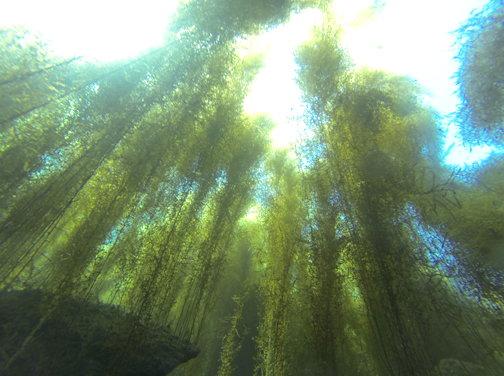
By Charly SHELTON
An invasive species has taken up residence in the rocky kelp forests of Southern California.
Sargassum horneri is macro algae seaweed that has moved in and taken the space and food source of many existing marine organisms. Also known as “devil weed,” this sea plant is common along the Japanese and Korean coastline but in recent years has spread to the American side of the Pacific, sweeping north from Baja California as it moves up the coast.
“Over the last couple of years, I’ve watched Sargassum horneri invade rocky subtidal dive spots off Southern California,” said Dominique Evans-Bye, Environmental GIS teacher at Clark Magnet High. “I’ve seen eel grass beds completely replaced off Anacapa Island.”
As part of her class, Evans-Bye encouraged her students to enter the Lexus Eco Challenge – LEC – a nationwide competition for grades six-12, to enter their action plans for solving an ongoing environmental problem affecting their area. One team, EcoNarcs 3.0, entered an action plan to use GIS – Geographic Information Systems – to help track the spread of Sargassum horneri. The team designed an app that divers can use to record sightings of devil weed and therefore increase the number of eyes on the lookout.
“Our study area was offshore California and Mexico, but we were only able to visit Catalina Island and Santa Cruz Island this year,” Evans-Bye. “To do the research, we used open data sources from University of California, Santa Barbara and crowdsourced our project using the local diving community to collect and record sightings of the algae using a mobile app we created.”
This proposal and the work that the students have been doing is grad student level work. It was submitted to the LEC and the EcoNarcs 3.0 won the land and water – LaW –portion of the challenge. They were awarded $10,000 for winning the LaW portion for their region. The $10,000 prize money will be split, with $7,000 to be divided among the students, $2,000 to the school for future projects and $1,000 to Evans-Bye for professional development.

Teams from Clark Magnet have already entered the other portion of the LEC, the air and climate [AaC] challenge.
“Four teams entered projects for the air and climate challenge,” Evans-Bye said. “The Reefolutionaries investigated the use of nuclear power for a zero-carbon energy source. They used GIS to select sites that would be suitable for new nuclear power plants. The Eco Squad investigated the feasibility of installing an electric car charging station on campus that would draw energy from our solar panel array for a zero carbon energy source. The Kids Fighting Contaminants joined forces with Toll Middle School and worked with Mrs. Mayer’s computer programming class to create a mobile gaming app that shows how methane emissions can be reduced through smart choices. The EcoNarcs 3.0, who worked on the Sargassum project and won the $10,000 for their region, took temperature measurements around the school campus and did a spatial analysis to document the microclimate of the school. They used the results of the analysis to determine the best placement of a ‘living wall’ as a way to decrease the heat signature of the school.”
The winners of the AaC challenge will move on with the winners of the LaW challenge, including EcoNarcs 3.0, to compete in the final challenge later this year.
“Students benefit by learning project management, teamwork, communication skills, analysis skills and more,” Evans-Bye said. “It is a great way to demonstrate the three-dimensional learning promoted by the Next Generation Science Standards.”
